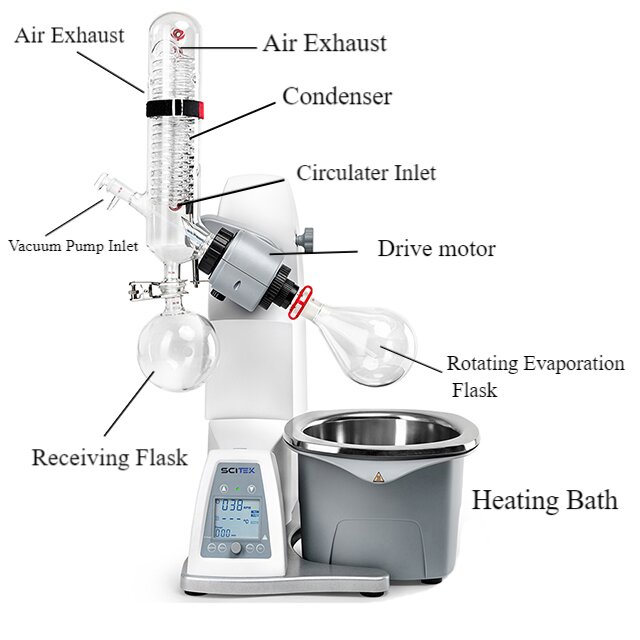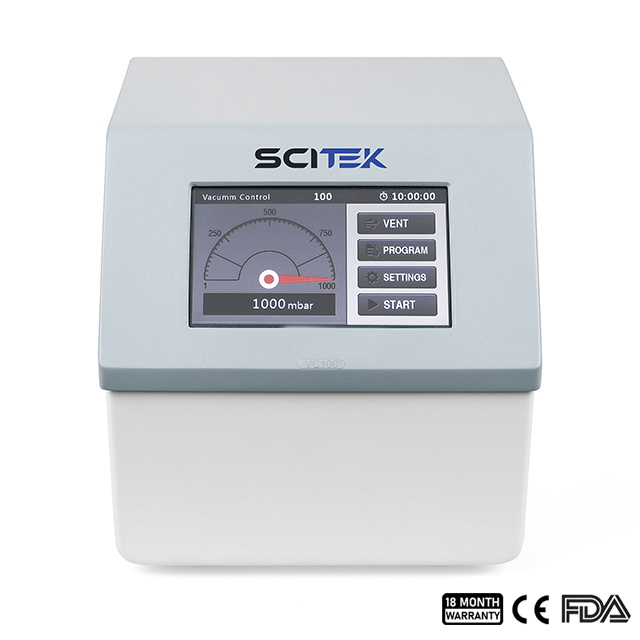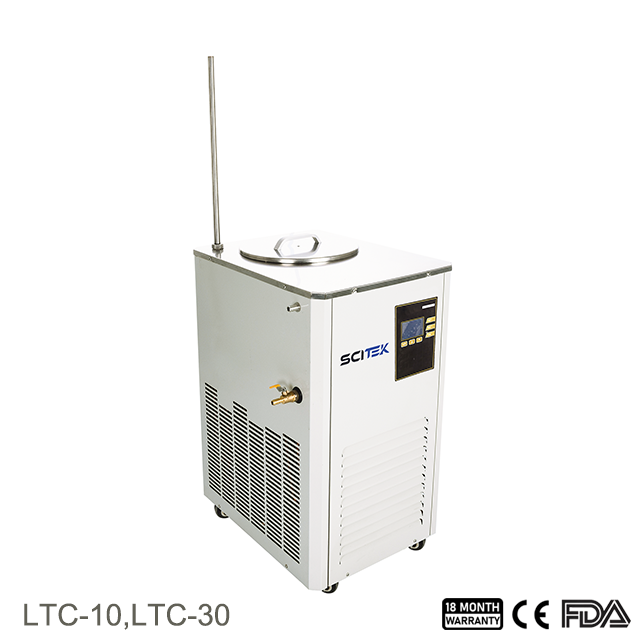Rotary evaporators are an essential laboratory instrument for concentrating, drying and recovering products. The rotary evaporation process is one of the most widely used solvent methods in pharmaceuticals, biotechnology, and other industries and fields. In addition to the continuous distillation of volatile solvents, rotary evaporators are also used for concentration, crystallization, drying, separation, and solvent recovery.
What are the Principles behind a Rotary Evaporator?
The basic principle of rotary evaporation is decompression distillation, in which large quantities of volatile solvents are distilled continuously under reduced pressure for separation and purification.
Under reduced pressure, the rotary evaporation flask is placed in a heated water bath and then continuously rotated and heated. At this point, substances with lower boiling points evaporate rapidly. The vapor is cooled and collected using a glass condenser in the receiving flask or vessel. This cycle continues until the solvent is completely collected.
Key Components of a Rotary Evaporator

To better understand how rotary evaporators function, let's explore their key components and features. Rotating evaporators consist of the following components:
1. Rotating evaporation flask: Usually, a round-bottomed flask is made of glass to hold the concentrated sample; flask is available in various sizes. It is usually placed in an oil or water bath for heating (heating is faster using an oil bath and there is less splashing when boiling and rotating).
2. Heating bath: Heating bath is used to heat the liquid inside the flask to ensure a consistent and accurate temperature during evaporation.
3. Drive motor: Provides power to the rotary evaporation flask so that the liquid inside can be heated more evenly to facilitate evaporation.
4. Condenser: The condenser is the key component of rotary evaporation and is made of a spiral glass tube. The vapor is condensed back to liquid form in the condenser.
5. Vacuum pump inlet: The vapor is reported faster by increasing the pressure and decreasing the temperature.
6. Receiving flask: The condensed solvent is collected in a receiving flask located below the condenser. This flask can be heated if required to promote further evaporation of the collected solvent.
What are the different types of rotary evaporators?
There are many types and configurations of Rotary Evaporator to choose from. Depending on the application requirements and design features, Rotary Evaporators can be classified as follows:
Traditional Rotary Evaporators

Electronic Rotary Evaporator
Rotary Speed : 0-120rpm; 0-110 rpm
Vacuum : 0.098 Mpa
Temp. Range : RT~400℃
Temp. Accuracy : ±1℃
Stroke Height : 120mm; 180mm
This type of rotary evaporator is commonly used in laboratories for general solvent evaporation and concentration. This is the most common type and includes a rotary flask, water bath, vacuum pump and condenser. Traditional rotary evaporators are manually operated and provide the basic rotational speed, temperature, and other conditions required for evaporation.
Digital Rotary Evaporator

Digital Rotary Evaporator
Rotary Speed : 0-180rpm
Temp. Range : RT~99℃
Temp. Accuracy : ±1℃
Stroke Height : 120mm
These rotary evaporators are equipped with a digital control panel for more accurate control of parameters such as rotational speed, water bath temperature, and vacuum level. Digital Rotary Evaporators are generally easier to operate and monitor.
Vacuum-Controlled Rotary Evaporators

Vacuum Controller
Vacuum Setting Range : 1-1000mbar
Vacuum Measurement Range : 1-1000mbar
Control Operation Mode : Single-point control mode, Programmed control mode
Sensor Overload Pressure : 1,500 mbar
Connector Diameter : 8mm
Vacuum-controlled rotary evaporators provide precise control of the vacuum level for improved control of the evaporation process. It is usually equipped with a powerful vacuum system and is suitable for evaporation operations that require higher vacuum levels, such as some gas-sensitive compounds.
Cold Trap Rotary Evaporators

Low temperature cooling liquid circulator
Temp. Control Accuracy : ±0.1 °C
Display Temp. Resolution : 0.1°C
Pump Lift : 4~6m
Circulating Pump Flow : 20~40L/min
Temp. Control Range : -20°C~RT; -40°C~RT

Low temperature cooling liquid circulator
Temp. Control Accuracy : ±0.1 °C
Display Temp. Resolution : 0.1°C
Pump Lift : 1.5~2.7m
Circulating Pump Flow : 8~16L/min
Temp. Control Range : -20°C~RT

Low Temperature Cooling Liquid Circulator
Usage Temperature Range : -10 ℃~RT; -30 ℃~RT; -40℃ ~RT
Environment Temperature : 5 ~35 ℃
Environment Humidity : ≤70% ventilation
Cold Trap Rotary Evaporators feature an additional cooling system to prevent volatile compounds from being lost during evaporation. Combining the functions of freeze drying and rotary evaporation, they are suitable for processing heat-sensitive samples.
Hybrid Rotary Evaporators
Hybrid Rotary Evaporators combine rotary evaporation with other processes, such as distillation or extraction.
Centrifugal Rotary Evaporator
A rotary evaporator uses centrifugal force to accelerate the evaporation process and increase efficiency. It usually consists of components such as a rotating vial, a heating bath, a vacuum system and a centrifugal device.
How does a rotary evaporator work?
A rotary evaporator works on the principle that solvents have a certain boiling point range, which decreases under reduced pressure. The evaporation flask rotates at a specified speed, forcing the material to form a large film on the inside wall of the flask. The flask is heated uniformly and substances with lower boiling points evaporate rapidly. After cooling through a glass condenser, the solvent stream is circulated in the receiving flask.
The workflow of the whole process is as follows:
1. The liquid sample is poured into the rotating flask.
2. A vacuum pump is activated to reduce the pressure inside the flask, making it easier for the sample to evaporate.
3. The heating system is activated to heat the sample in the rotating flask.
4. The evaporated gas is cooled to liquid by a condenser.
5. The condensed liquid enters the collection bottle and completes one round of the evaporation cycle.
This process can be repeated until the desired concentration or separation goal is reached.
Advantages of using a rotary evaporator
1. Rotary evaporator can evaporate liquid samples quickly and efficiently using a rotating vial and a heating system so that the solvent in a solution is rapidly converted into vapor.
2. Rotary evaporator can concentrate a large volume of liquid solution into a relatively small volume, increasing the concentration of solutes in solution.
3. Its efficient evaporation mechanism, rotary evaporator can usually complete the sample processing in a relatively short period, thus saving laboratory operation time and energy costs.
4. Simple control panel for easy operation.
5. It can handle various solvents, making it suitable for different fields and laboratory applications.
6. Adjusting the vacuum can better control the rate of sample evaporation and avoid problems caused by excessive volatilization.
7. Some rotary evaporators have automated functions that allow them to set up and execute predetermined procedures to improve the repeatability and efficiency of experiments.
These advantages make rotary evaporators a common and important tool in laboratories, widely used in chemistry, biology, pharmaceuticals and the environment.
What factors are important when choosing a rotary evaporator?
When choosing a rotary evaporator, it is important to consider the following factors to ensure that the equipment meets your experimental needs:
1. Solvent type: Know what type of solvents you typically use. Some rotary evaporators may be better for specific solvents, so ensure the equipment can handle your experimental samples.
2. Heating and cooling capacity: The temperature difference between the solvent solution and the condenser must be sufficient.
3. Flask size: Choose a flask size appropriate for the volume of solvent you want to use.
4. Evaporation rate: consider the rotary evaporator's evaporation rate and ensure it is sufficient for your needs.
5. Vacuum pump: ensure that the rotary evaporator you choose is compatible with the vacuum pump you will use.
6. Water bath: Consider the size and type of water bath that comes with your rotary evaporator.
7. Safety features: make sure the rotary evaporator you choose has the necessary safety features, such as a temperature control system and an auto shut-off feature.
8. Cost: Last but not least is cost. Make sure that you consider your budget and strike a balance between performance, features and budget.
Considering these factors, you can choose the rotary evaporator that suits your needs and budget!
What are some common applications of rotary evaporators?
1. Solvent Removal and Concentration: Removing solvents from liquid samples is one of the main applications of rotary evaporators. It is particularly useful in chemical synthesis, where researchers must concentrate reaction products, purify molecules, or isolate specific chemicals.
2. Drug discovery: Rotary evaporators are widely used by pharmaceutical researchers to concentrate and purify active pharmaceutical ingredients (APIs) from complex mixtures. This helps in drug research, formulation and quality control.
3. Essential Oil Extraction: Rotary evaporators extract essential oils from plants and herbs in the food, cosmetic and perfume sectors. The delicate aromatic components are preserved through a gentle evaporation process.
4. Solvent recovery: Rotary evaporators can be used with solvent recovery systems, enabling laboratories and companies to recover and reuse solvents while reducing waste and operating costs.
5. Teaching: Rotary evaporators are widely used to explain solvent evaporation principles and teach students laboratory practices.
6. Polymer research: Rotary evaporators help to remove residual monomers or solvents from manufactured polymers, ensuring high purity and improved properties.
Conclusion
The role of the rotary evaporator is becoming increasingly important in the laboratory, providing scientists with an efficient and precise solution for solvent evaporation. It not only simplifies the experimental process and improves the efficiency, but also provides scientists with a broader experimental space. Through this article we have gained an insight into the working principle of rotary evaporators, their application areas and their importance in the laboratory workflow. In the future, we can expect to see more stories about rotary evaporators coming into their own in various scientific fields, injecting new vigour into the development of laboratories.

 English
English













